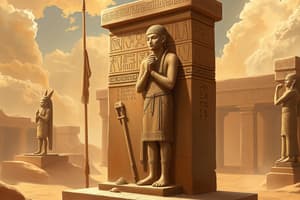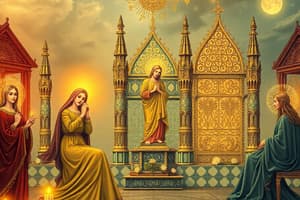Podcast
Questions and Answers
What is the material used in the Statues of Votive Figures?
What is the material used in the Statues of Votive Figures?
- Wood
- Gypsum inlaid with shell (correct)
- Bronze
- Marble
What aspect of religion do votive figures represent?
What aspect of religion do votive figures represent?
The aspect of Mesopotamian religion as representations of mortal men and women.
What do worshippers do with images of themselves?
What do worshippers do with images of themselves?
Set up images of themselves in a shrine before a larger image of god.
What is a characteristic feature of the faces and bodies of the statues?
What is a characteristic feature of the faces and bodies of the statues?
What two types of clothing can be identified in the art history concept?
What two types of clothing can be identified in the art history concept?
How are males depicted in the statues?
How are males depicted in the statues?
What is a feature of the eyes of the figures?
What is a feature of the eyes of the figures?
What was the purpose of the inscriptions on the statues?
What was the purpose of the inscriptions on the statues?
What does the stocky body type of the statues symbolize?
What does the stocky body type of the statues symbolize?
What does the arched eyebrows inlaid with materials show?
What does the arched eyebrows inlaid with materials show?
What do the statues of votive figures represent?
What do the statues of votive figures represent?
How is the hierarchical scale represented in the statues?
How is the hierarchical scale represented in the statues?
Flashcards are hidden until you start studying
Study Notes
Statues of Votive Figures Overview
- Originated from the Square Temple at Eshnunna (modern Tell Asmar, Iraq)
- Created in Sumerian culture around 2700 BCE, made of gypsum inlaid with shell and limestone
Context
- Integral aspect of Mesopotamian religion, representing mortal men and women as votive figures
- Worshippers installed their images in shrines before larger deities, serving as a devotional act
Form and Design
- Features stylized representations with V-shaped bodies and flared skirts, not realistic portraits
- Unique clothing styles: men wore bare-chested sheep skin shirts; women wore full skirts with one shoulder exposed
- No depictions of nudity in Mesopotamian and Egyptian art, contrasting with Greek depictions
Artistic Characteristics
- Figures exhibit wide-eyed expressions and an upward head tilt, conveying devotion and attentiveness
- Detailed arching brows inlaid with dark materials enhance the representation of wealth and piety
- Stocky and muscular bodies, emphasizing robustness suitable for continuous worship
Scale and Representation
- Hierarchical scale evident in proportions, such as larger eyes compared to hands, emphasizing key features
- Frontal positioning of statues despite curved sides allows for a continuous gaze towards deities
Functionality and Purpose
- Inscription serves three main functions:
- Remind gods of the votive offerings and request favor
- Express wishes of the donor
- Augment the donor's reputation through wealth display
- Statues acted as stand-ins for donors, ensuring constant reverence in the presence of the divine
Cultural Significance
- Wide eyes facilitate uninterrupted connection to the god, reflecting the importance of readiness in worship
- The upward tilt of heads indicates a lower status in the divine hierarchy
- Robust body types symbolize the strength needed for enduring 24/7 worship practices
Artistic Choices
- Material and simplified portraits prioritize speed and efficiency in the creation process, focusing on essential spiritual characteristics
Studying That Suits You
Use AI to generate personalized quizzes and flashcards to suit your learning preferences.


